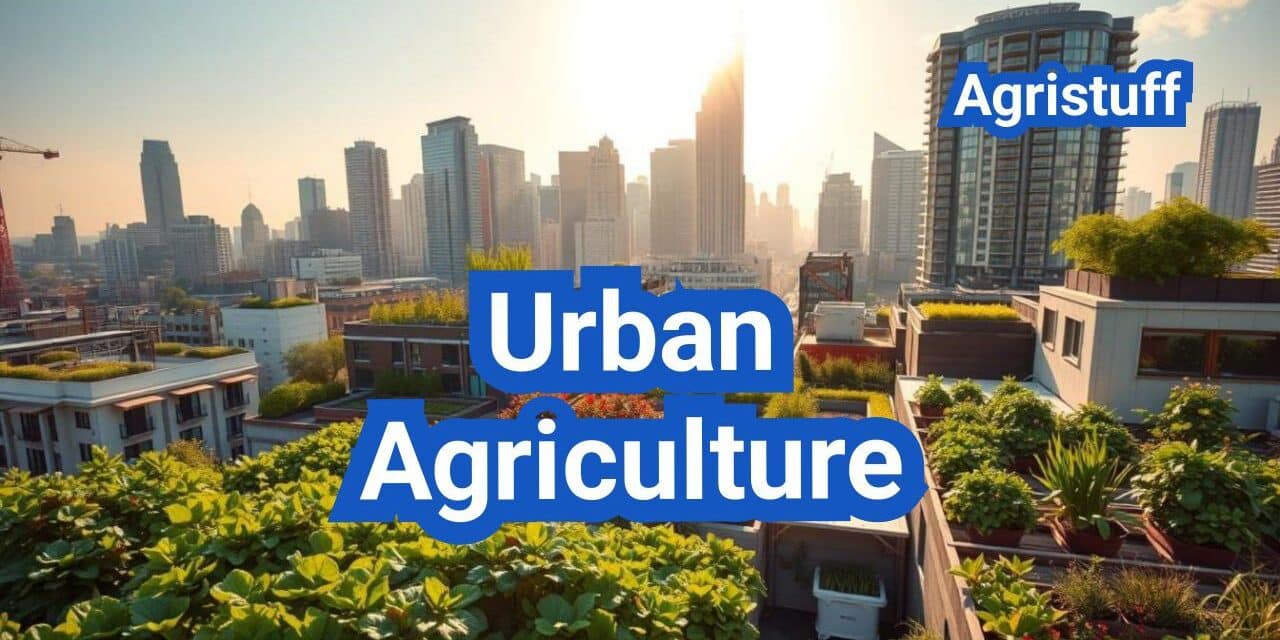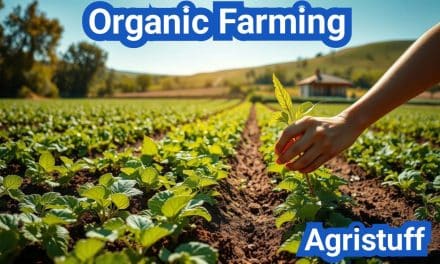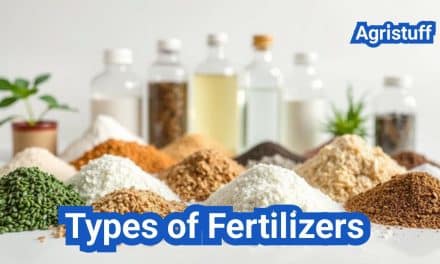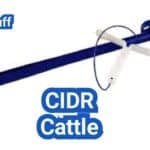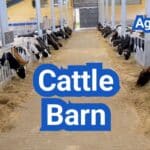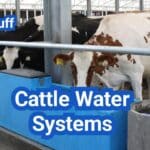Urban agriculture is transforming the way cities produce and consume food. It encompasses the cultivation, processing, and distribution of agricultural products within urban and suburban areas, enhancing food security and sustainability.
This practice not only provides fresh produce to local communities but also contributes to the economic vitality of urban centers. By understanding the zoning laws, market demands, and profitable crops, individuals can capitalize on the opportunities presented by urban agriculture in the U.S.
Key Takeaways
- Urban agriculture enhances food security and sustainability in urban areas.
- It involves the cultivation, processing, and distribution of agricultural products.
- Understanding zoning laws is crucial for urban agriculture.
- Market demands and profitable crops are key to successful urban agriculture.
- Urban agriculture contributes to the economic vitality of urban centers.
Understanding Urban Agriculture in America
The concept of urban agriculture has gained significant traction in recent years, driven by its potential to enhance food security and urban sustainability. Urban agriculture, in its broadest sense, refers to the cultivation, processing, and distribution of food within urban areas. This practice not only provides fresh produce to city dwellers but also contributes to the aesthetic and environmental quality of urban environments.
What Is Urban Agriculture?
Urban agriculture encompasses a wide range of activities, from small backyard gardens and community plots to large commercial rooftop farms and vertical farming operations. As noted by the USDA, urban agriculture plays a crucial role in fostering community engagement and improving access to healthy food options in urban settings. “Urban agriculture is a vital part of the food system, providing numerous benefits to individuals, communities, and the environment,” according to a report by the National Agricultural Library.
The Evolution of City Farming in the U.S.
The history of urban agriculture in the United States is rich and varied, with roots tracing back to early 20th-century victory gardens during World War II. These gardens were not only a source of food but also a symbol of patriotism and community resilience. In modern times, urban farming has evolved to include sophisticated hydroponic and aeroponic systems, as well as innovative approaches to utilizing urban spaces for food production.
“The future of urban agriculture lies in its ability to adapt to changing urban landscapes and to innovate in response to environmental challenges.”
Environmental and Social Benefits
Urban agriculture offers numerous environmental benefits, including reduced carbon footprints from transportation, increased green spaces that mitigate the urban heat island effect, and improved air quality. Socially, urban farming initiatives often serve as community hubs, promoting social cohesion and providing educational opportunities in sustainable food systems.
- Enhances food security and access to fresh produce
- Fosters community engagement and social connections
- Contributes to urban sustainability and environmental health
By understanding the multifaceted benefits and historical context of urban agriculture, we can better appreciate its potential to transform urban environments and contribute to a more sustainable food system.
Types of Urban Agriculture Systems

The concept of urban agriculture encompasses various innovative systems that allow for efficient and productive farming in urban environments. These systems cater to different needs and spaces, from small community gardens to large-scale indoor operations.
Community Gardens and Shared Spaces
Community gardens are a cornerstone of urban agriculture, providing shared spaces where individuals can grow their own fruits, vegetables, and flowers. These gardens not only supply fresh produce but also serve as community hubs, fostering social connections and a sense of community.
Benefits of community gardens include improved food security, enhanced community engagement, and educational opportunities for sustainable gardening practices.
Rooftop Farms and Gardens
Rooftop farms and gardens utilize otherwise unused rooftop spaces for agricultural production. These areas can be converted into productive farms, providing fresh produce to building occupants or local markets.
Rooftop farming often involves intensive planning to ensure structural integrity, manage weight, and control environmental factors like wind and temperature.
Vertical Farming Innovations
Vertical farming represents a significant innovation in urban agriculture, involving the use of vertical space to increase crop yields per square foot. This method often incorporates hydroponics or aeroponics, reducing water usage and increasing efficiency.
Vertical farms can be located indoors or outdoors and are particularly suited to urban areas where land is scarce.
Indoor Growing Operations
Indoor growing operations involve cultivating crops within enclosed environments, such as warehouses or containers. These operations use controlled environment agriculture (CEA) techniques, including LED lighting and climate control, to optimize growing conditions.
Advantages of indoor growing include year-round production, reduced land use, and the ability to grow crops in any climate or season.
Navigating City Farming Zoning Laws
Zoning laws significantly impact urban agriculture, with regulations varying by city and jurisdiction, making it essential for urban farmers to understand these laws.
Understanding Local Regulations
Urban farmers must familiarize themselves with local zoning ordinances, which can be complex and vary significantly from one city to another. Researching local regulations is the first step in ensuring compliance and avoiding potential legal issues.
Many cities have specific zoning laws that pertain to urban agriculture, including rules about plot size, location, and the types of activities allowed. For instance, some cities may restrict farming in residential areas or require special permits for certain types of agricultural activities.
Common Zoning Challenges for Urban Farmers
Urban farmers often face several zoning challenges, including restrictions on signage, hours of operation, and the sale of products directly from the farm. Understanding these challenges is crucial for developing strategies to overcome them.
- Restrictions on the types of crops that can be grown
- Limitations on the use of equipment and machinery
- Requirements for setbacks and buffers
How to Apply for Permits and Variances
To operate an urban farm legally, farmers may need to obtain permits or variances from the local government. Preparing a comprehensive application that addresses zoning requirements and demonstrates the farm’s compliance with local regulations is essential.
The process typically involves submitting detailed plans, participating in public hearings, and addressing any concerns raised by neighbors or local officials.
Working with City Officials
Building a positive relationship with city officials can facilitate the process of navigating zoning laws. Engaging in open communication and being responsive to concerns can help urban farmers secure the necessary approvals and permits.
By understanding and complying with city farming zoning laws, urban farmers can minimize legal risks and focus on building successful and sustainable agricultural projects.
Starting Your Urban Farm: Step-by-Step Guide

Launching a successful urban farm requires a systematic approach, from site selection to team building. This guide will walk you through the essential steps to establish a thriving urban agricultural operation.
Site Selection and Assessment
The first step in starting your urban farm is to identify a suitable location. Site selection is crucial as it determines the viability of your farming operation. Consider factors such as sunlight exposure, soil quality, and accessibility.
Assessing the site involves evaluating its potential for farming. Check for any contaminants in the soil and ensure that the site is relatively flat and well-drained. Environmental factors such as wind direction and proximity to pollution sources should also be considered.
Initial Setup and Infrastructure
Once you have selected your site, the next step is to set up the necessary infrastructure. This includes preparing the soil, installing irrigation systems, and constructing any necessary structures such as greenhouses or cold frames.
Developing a robust infrastructure is vital for the long-term success of your urban farm. It not only enhances productivity but also helps in managing resources efficiently.
Essential Equipment and Tools
Urban farming requires a variety of equipment and tools. Basic necessities include hand tools like trowels and pruners, as well as irrigation equipment and possibly machinery for larger operations.
- Hand tools for planting and maintenance
- Irrigation systems for efficient water use
- Greenhouse or cold frame structures for climate control
- Machinery for larger scale operations
Building Your Team
No urban farm can succeed without a dedicated team. Whether you’re starting small or scaling up, having the right people with the necessary skills is crucial. Consider recruiting volunteers, hiring experienced farmhands, or partnering with local organizations to build your team.
Team building involves not just recruiting but also training and retaining staff. Providing ongoing education and creating a positive work environment are key to maintaining a motivated and productive team.
Urban Soil Testing and Management
As urban agriculture continues to grow, the need for effective soil testing and management becomes increasingly important. Urban soils can be contaminated with various pollutants, including heavy metals, pesticides, and industrial chemicals, which can pose significant risks to human health and the environment.
Identifying Soil Contaminants
The first step in managing urban soils is to identify potential contaminants through comprehensive urban soil testing. This process typically involves collecting soil samples and analyzing them for a range of pollutants. Common contaminants in urban soils include lead, arsenic, and polycyclic aromatic hydrocarbons (PAHs).
Understanding the sources of these contaminants is crucial for developing effective remediation strategies. For instance, lead contamination is often associated with older buildings where lead-based paint was used, while PAHs can result from industrial activities or vehicle emissions.
Remediation Techniques for Urban Soils
Once soil contaminants are identified, various remediation techniques can be employed to mitigate their impact. These techniques range from simple methods like soil replacement or dilution to more complex approaches such as phytoremediation, where plants are used to absorb or stabilize contaminants.
- Phytoremediation: Using plants to clean up contaminated soils.
- Soil washing: Removing contaminants from soil through a washing process.
- Containment: Isolating contaminated soil to prevent further pollution.
Selecting the most appropriate remediation technique depends on the type and extent of contamination, as well as economic and environmental considerations.
Building Healthy Soil in City Environments
After addressing contaminants, the next step is to build healthy soil in urban environments. This involves improving soil structure, enhancing nutrient content, and promoting beneficial microbial activity. Strategies for achieving healthy urban soils include adding organic amendments like compost, using cover crops, and minimizing tillage to preserve soil integrity.
Creating healthy soil not only supports robust plant growth but also contributes to broader environmental benefits, such as improved water quality and reduced urban heat island effects.
By prioritizing urban soil testing and management, urban farmers and gardeners can help ensure the long-term sustainability of their agricultural projects while contributing to a healthier urban environment.
Hydroponic Systems for Apartments and Small Spaces

Hydroponic systems are revolutionizing urban agriculture by enabling individuals to grow their own food in apartments and small spaces. This method of farming is particularly suited for city dwellers who have limited room but are eager to cultivate their own crops.
Basic Hydroponic Setups for Beginners
For those new to hydroponics, starting with a simple system is crucial. Basic setups include the Nutrient Film Technique (NFT) and Ebb and Flow systems. These are relatively easy to establish and maintain, making them perfect for beginners. NFT systems involve a continuous flow of nutrient-rich water over the roots of the plants, while Ebb and Flow systems periodically flood the grow tray.
When choosing a hydroponic system, consider the space available and the type of crops you wish to grow. Leafy greens and herbs are popular choices for hydroponic systems due to their ease of growth and quick turnaround.
Nutrient Management and Water Systems
Effective nutrient management is critical in hydroponics. The nutrient solution must be balanced to provide all the necessary elements for plant growth. Regular monitoring of the pH and EC (Electrical Conductivity) of the solution is essential to ensure optimal growing conditions.
Water management is also a key aspect of hydroponic systems. Recirculating systems help conserve water by reusing the nutrient solution, reducing waste and minimizing the environmental impact.
Space-Efficient Designs for Urban Settings
In urban settings, space is often at a premium. Hydroponic systems can be designed to maximize space efficiency, using vertical grow towers or wall-mounted units. These designs allow for a significant amount of produce to be grown in a relatively small footprint.
Another space-saving approach is the use of modular hydroponic systems, which can be expanded or contracted as needed. This flexibility is particularly useful in urban environments where space constraints can vary.
Troubleshooting Common Issues
Despite the many advantages of hydroponic systems, issues can arise. Common problems include nutrient deficiencies, pH imbalances, and water temperature fluctuations. Regular monitoring and maintenance are key to preventing these issues.
For example, maintaining a stable pH between 5.5 and 6.5 is crucial for nutrient uptake. Similarly, ensuring that the water temperature remains within a suitable range for the crops being grown is vital for healthy plant development.
Setting Up a Rooftop Greenhouse Agriculture

Rooftop greenhouses are revolutionizing urban agriculture by providing a controlled environment for crop production. This innovative approach to farming is not only increasing food production in urban areas but also contributing to a more sustainable urban ecosystem.
Structural Considerations and Requirements
When setting up a rooftop greenhouse, it’s crucial to consider the structural integrity of the building. The weight of the greenhouse, including soil, plants, and irrigation systems, must be supported by the roof. Structural assessments should be conducted to ensure that the roof can bear the load. Additionally, accessibility for maintenance and potential upgrades should be factored into the design.
The choice of materials for the greenhouse is also critical. Durable, weather-resistant materials that can withstand the elements and provide adequate insulation are essential. Greenhouse design should also incorporate features that maximize natural light while minimizing heat loss.
Climate Control and Water Management
Effective climate control is vital in a rooftop greenhouse to create an optimal growing environment. This includes regulating temperature, humidity, and light levels. Advanced systems can automate these processes, ensuring that crops are grown under ideal conditions.
Water management is another critical aspect. Implementing efficient irrigation systems that minimize water waste while ensuring plants receive adequate hydration is key. Techniques such as drip irrigation and rainwater harvesting can significantly reduce water consumption.
Crop Selection for Rooftop Environments
The selection of crops for a rooftop greenhouse depends on several factors, including the local climate, market demand, and the specific conditions within the greenhouse. Crops that thrive in controlled environments, such as leafy greens, herbs, and certain fruits, are often well-suited. The ability to control temperature and humidity allows for the cultivation of a wide range of crops year-round.
Understanding the market demand for specific crops is also crucial. Growing crops that are in high demand can significantly impact the profitability of the rooftop greenhouse operation.
Most Profitable Crops for Urban Farming

Maximizing profits in urban farming requires a deep understanding of the most lucrative crops and how to grow them effectively. Urban farmers can significantly benefit from growing high-value crops that are in demand in local markets.
Microgreens: High-Value, Quick Turnaround
Microgreens are young, nutrient-dense versions of leafy greens and other vegetables. They are highly profitable due to their short growth cycle and high market demand. Typically, microgreens are ready to harvest within 7-21 days, allowing for multiple crops in a short period.
Growing microgreens requires minimal space and can be done indoors or outdoors. They can be sold at a premium price due to their nutritional value and culinary appeal.
Cut Flowers for Urban Markets
Cut flowers are another lucrative option for urban farmers. They can be grown in greenhouses or indoor spaces, providing a year-round supply. Choosing varieties that are in season and in demand is crucial for maximizing profits.
Cut flowers not only provide a beautiful product for consumers but also offer a potentially high return on investment due to their popularity in events and decorations.
Specialty Herbs and Vegetables
Specialty herbs and vegetables, such as heirloom tomatoes and exotic herbs, are in high demand in urban markets. These crops can command higher prices due to their unique qualities and the growing interest in gourmet cuisine.
Growing specialty crops requires careful planning and knowledge of market trends. Urban farmers should focus on crops that have a strong local demand and can be grown efficiently.
Year-Round Growing Strategies
To maximize profitability, urban farmers need to adopt year-round growing strategies. This can involve using greenhouses, indoor growing systems, or succession planting to ensure a continuous supply of crops.
By diversifying the types of crops grown and using season extension techniques, urban farmers can maintain a steady income stream throughout the year.
Developing an Urban Farming Business Plan

A well-structured business plan is the backbone of any successful urban farming venture. It serves as a roadmap, guiding farmers through the complexities of market analysis, financial management, and scaling strategies.
Market Analysis and Target Customers
Understanding the market is crucial for urban farming success. This involves identifying target customers, analyzing competitors, and recognizing market trends. Urban farmers should conduct thorough market research to determine the demand for their products and tailor their production accordingly.
Key components of market analysis include:
- Identifying target demographics and customer needs
- Analyzing competitors and market gaps
- Assessing market trends and future projections
Financial Projections and Startup Costs
Financial planning is a critical aspect of any business plan. Urban farmers need to estimate startup costs, including infrastructure, equipment, and initial operational expenses. They should also project revenue streams and ongoing expenses to create a comprehensive financial plan.
| Startup Costs | Estimated Cost |
|---|---|
| Infrastructure (e.g., greenhouse, irrigation system) | $10,000 – $50,000 |
| Equipment (e.g., seeds, tools, hydroponic systems) | $5,000 – $20,000 |
| Initial Operational Expenses (e.g., labor, marketing) | $8,000 – $30,000 |
Scaling Strategies for Growth
As urban farming businesses grow, they need to develop strategies to scale their operations. This might involve expanding production capacity, diversifying products, or exploring new markets.
Effective scaling strategies include:
- Investing in technology to improve efficiency
- Diversifying product offerings to meet changing consumer demands
- Exploring new distribution channels and markets
Securing Funding and Resources
Urban farmers often need to secure external funding to launch or expand their operations. This can involve applying for grants, loans, or investors. Building a strong business plan is essential for attracting funding.
Potential funding sources include:
- Government grants and subsidies for urban agriculture
- Private investors and venture capitalists
- Crowdfunding platforms
Urban Agriculture and Regional Food Systems
Urban agriculture plays a crucial role in developing sustainable regional food systems. By integrating urban farming into the fabric of city planning, communities can enhance food security, support local economies, and promote sustainable practices.
Connecting with Local Food Networks
Urban agriculture is vital for connecting consumers with local food networks. This connection not only ensures fresher produce but also supports local farmers by providing them with a direct market. Local food networks help in reducing the carbon footprint associated with transporting food over long distances.
To effectively connect with local food networks, urban farmers can participate in or initiate programs such as community-supported agriculture (CSA) and farmers’ markets. These platforms allow for direct interaction between consumers and producers, fostering a sense of community and promoting the local economy.
Contributing to Food Security
Urban agriculture significantly contributes to food security by providing communities with access to fresh, nutritious produce. In urban areas where access to healthy food options may be limited, urban farming can be a game-changer.
By cultivating a variety of crops in urban settings, cities can reduce their reliance on industrial agriculture and enhance their resilience to food system disruptions. This approach also helps in educating consumers about the importance of sustainable food practices.
Building Sustainable Supply Chains
Building sustainable supply chains is another critical aspect of urban agriculture in regional food systems. Urban farms can supply fresh produce to local restaurants, grocery stores, and other consumers, thereby reducing the environmental impact of food distribution.
| Benefits | Description | Impact |
|---|---|---|
| Enhanced Food Security | Increased access to fresh, nutritious produce | Improved public health |
| Support for Local Economies | Direct sales to consumers and local businesses | Boosts local economic activity |
| Sustainable Practices | Reduced carbon footprint, efficient water use | Environmental sustainability |
By focusing on these areas, urban agriculture can play a transformative role in regional food systems, contributing to a more sustainable and equitable food future.
Selling at Farmers Markets: Permits and Best Practices

Selling at farmers markets can be a lucrative venture for urban farmers, but it requires careful planning and compliance with regulations. To succeed, urban farmers must navigate the complex landscape of permits, licenses, and market dynamics.
Obtaining Necessary Permits and Licenses
Before setting up a stall at a farmers market, urban farmers must obtain the necessary permits and licenses. These requirements vary by location, but typically include a business license, sales tax permit, and health department permit. It’s essential to research the specific requirements for your area to avoid fines or market expulsion.
For example, a farmer in California may need to obtain a Certificate of Origin from the county agricultural commissioner’s office. Similarly, farmers selling organic produce may need to display their USDA Organic certification. Ensuring compliance with these regulations not only avoids legal issues but also builds trust with customers.
| Permit/License | Description | Typical Issuing Authority |
|---|---|---|
| Business License | Required for operating a business within a jurisdiction | City or County Clerk’s Office |
| Sales Tax Permit | Necessary for collecting and remitting sales tax | State Tax Authority |
| Health Department Permit | Ensures compliance with health and safety regulations | Local Health Department |
Setting Up an Attractive Market Stand
An attractive and well-organized market stand is crucial for drawing in customers. This includes clear signage, appealing displays, and a clean, organized setup. Urban farmers should also consider offering samples to encourage sales and build customer loyalty.
Accepting SNAP EBT and Other Payment Methods
To maximize sales, urban farmers should consider accepting a variety of payment methods, including SNAP EBT (Supplemental Nutrition Assistance Program Electronic Benefits Transfer). This not only broadens the customer base but also supports the community by making fresh produce more accessible to low-income families.
Farmers can apply for SNAP EBT through their state’s EBT program or through the USDA’s website. Additionally, many farmers markets now offer wireless EBT processing, making transactions smoother and more efficient.
Building Customer Relationships
Building strong relationships with customers is key to long-term success at farmers markets. This can be achieved through excellent customer service, engaging with customers about the produce, and offering loyalty programs or newsletters to keep customers informed about new products and market events.
By focusing on these areas, urban farmers can not only comply with the necessary regulations but also thrive in the competitive environment of farmers markets.
Community Supported Agriculture (CSA) Models

Community Supported Agriculture (CSA) models have emerged as a vital marketing strategy for urban farmers, fostering a direct connection between consumers and local produce. This approach not only provides a stable income stream for farmers but also promotes local food systems and community engagement.
Designing a Successful CSA Program
To design a successful CSA program, urban farmers must consider several key factors. First, they need to determine the size of their operation based on available land, resources, and market demand. It’s also crucial to develop a diverse range of crops to attract a broad membership base. Efficient planning and management are essential to ensure a consistent supply of fresh produce throughout the growing season.
Another important aspect is setting a fair pricing structure that balances the needs of both the farmer and the consumer. This involves calculating costs, considering the value of the produce, and researching what similar CSA programs are charging. Transparency about the farming practices, crop yields, and distribution methods can also help build trust with potential members.
Member Recruitment and Retention
Recruiting and retaining members are critical to the success of a CSA program. Effective strategies include leveraging social media platforms, participating in local food festivals, and collaborating with other urban farmers to promote the benefits of CSA models. Clear communication about the program’s details, such as pickup locations, distribution schedules, and the variety of produce, is vital.
To retain members, farmers should focus on delivering high-quality produce consistently and providing excellent customer service. Engaging members through newsletters, farm events, and volunteer opportunities can also foster a sense of community and loyalty.
Seasonal Planning for Consistent Harvests
Seasonal planning is essential for maintaining a consistent harvest and meeting member expectations. Urban farmers should develop a comprehensive planting schedule that takes into account the local climate, soil conditions, and crop rotation principles. This planning helps in managing risks associated with weather variability and pests.
By diversifying crops and using season extension techniques such as hoop houses or cold frames, farmers can extend the growing season and provide a more consistent supply of produce to their members. Regular monitoring of weather forecasts and being prepared to adapt plans as needed are also crucial strategies.
Composting and Waste Management in Cities

Composting is revolutionizing urban agriculture by turning waste into a valuable resource. As cities grow, managing waste effectively becomes a significant challenge. Composting offers a solution by reducing waste sent to landfills and creating a nutrient-rich soil amendment for urban farms and gardens.
Small-Space Composting Systems
Urban residents often face space constraints, making traditional composting methods challenging. However, innovative small-space composting systems have been developed to address this issue. These include:
- Compact compost bins designed for indoor or outdoor use
- Worm composting (vermicomposting) systems that utilize worms to break down organic waste
- Bokashi bins that ferment food waste, reducing odors and mess
These systems enable city dwellers to compost effectively, even in small apartments or homes without yards.
Managing Compost in Urban Settings
Managing compost in urban settings requires careful consideration of odor control, pest management, and maintaining the right carbon-to-nitrogen ratio. Proper compost management not only reduces waste but also produces a valuable resource for urban agriculture.
“Composting is a critical component of sustainable urban living, turning what would be waste into a resource that enhances soil health and supports local food systems.”
Using Compost to Improve Urban Soils
Urban soils are often degraded due to contamination, compaction, and lack of organic matter. Compost can significantly improve these soils by:
- Enhancing soil structure and water retention
- Providing essential nutrients for plant growth
- Supporting beneficial microbial activity
By incorporating compost into urban soils, farmers and gardeners can improve soil health, increase crop yields, and contribute to a more sustainable urban food system.
Urban Agriculture Jobs and Career Opportunities
Urban agriculture is not just about growing crops; it’s about building a career in a field that’s both challenging and rewarding. As cities continue to embrace sustainable practices, the demand for professionals in urban agriculture is on the rise.
Types of Employment in Urban Farming
Urban agriculture encompasses a wide range of job opportunities, from farming and education to entrepreneurship and advocacy. Some of the key roles include:
- Farm Managers: Oversee daily operations, crop planning, and staff management.
- Agricultural Specialists: Provide expertise in areas like soil science, irrigation, and pest management.
- Education and Outreach Coordinators: Develop programs to educate the community about urban agriculture.
- Entrepreneurs: Start and manage their own urban farming businesses, creating products or services related to urban agriculture.
According to a report, “Urban agriculture offers a range of job opportunities, from farming and education to entrepreneurship and advocacy.” This diversity in roles highlights the complexity and richness of the urban agriculture sector.
Skills and Training Requirements
To succeed in urban agriculture, individuals need a combination of practical skills and knowledge in areas such as:
| Skill | Description |
|---|---|
| Agricultural Practices | Understanding of crop rotation, soil health, and irrigation systems. |
| Business Management | Knowledge of financial planning, marketing, and management. |
| Community Engagement | Ability to work with diverse communities, educate, and promote urban agriculture. |
Training programs and certifications can provide the necessary skills. Many institutions now offer courses in urban agriculture, sustainable farming practices, and agricultural entrepreneurship.
“The future of urban agriculture depends on our ability to innovate and adapt, ensuring that we can feed our cities sustainably.”
— Expert in Urban Agriculture
Entrepreneurship in Urban Agriculture
Entrepreneurship plays a crucial role in the development of urban agriculture. By starting their own businesses, individuals can create innovative products or services that contribute to the sustainability of urban food systems.
Some successful urban agriculture business models include:
- Microgreens production for high-end restaurants.
- Community-supported agriculture (CSA) programs.
- Urban farming education and consulting services.
These entrepreneurial ventures not only provide income opportunities but also help to build more resilient and sustainable urban food systems.
The Future of Urban Agriculture in America
Urban agriculture is poised for continued growth in America, driven by increasing demand for local and sustainable food systems. As the sector evolves, new trends and opportunities are emerging, from innovative hydroponic systems to rooftop greenhouses.
The future of urban agriculture in America will be shaped by the ability to address challenges such as zoning regulations, soil contamination, and climate change. By working together, urban farmers, policymakers, and community leaders can create a more sustainable and equitable food system.
With the right support and innovation, urban agriculture can continue to thrive, providing fresh produce to communities, creating jobs, and contributing to a more environmentally conscious economy. As urban agriculture programs expand, they will play a critical role in shaping the future of food production in America.
FAQ
What is urban agriculture?
Urban agriculture refers to the practice of cultivating, processing, and distributing food in or around urban areas. It encompasses a range of activities, including farming, gardening, and animal husbandry, and can be practiced in a variety of settings, from backyard gardens to rooftop farms.
What are the benefits of urban agriculture?
Urban agriculture provides numerous benefits, including increased food security, improved air and water quality, and enhanced community engagement. It also offers opportunities for economic development, job creation, and education.
What types of crops are most profitable for urban farming?
Microgreens, cut flowers, and specialty herbs are among the most profitable crops for urban farming. These crops are in high demand, can be grown in small spaces, and can be harvested quickly, making them ideal for urban farming operations.
How do I navigate city farming zoning laws?
To navigate city farming zoning laws, it’s essential to understand local regulations, obtain necessary permits, and work with city officials. This may involve researching zoning ordinances, consulting with local experts, and attending public hearings.
What is hydroponic farming, and how does it work?
Hydroponic farming is a method of growing plants in a nutrient-rich solution rather than soil. This approach allows for precise control over nutrient levels, water usage, and climate, making it well-suited for urban environments.
How do I start an urban farm?
To start an urban farm, begin by assessing your site, developing a business plan, and securing necessary permits and funding. You’ll also need to acquire essential equipment, build your team, and establish a marketing strategy.
What is the role of community gardens in urban agriculture?
Community gardens play a vital role in urban agriculture by providing shared spaces for gardening, education, and community building. They help to promote food security, social cohesion, and environmental stewardship.
How can I sell my urban farm products?
You can sell your urban farm products through various channels, including farmers markets, community-supported agriculture (CSA) programs, and online platforms. You may also consider partnering with local restaurants, grocery stores, or food cooperatives.
What is the importance of soil testing in urban agriculture?
Soil testing is crucial in urban agriculture because it helps to identify soil contaminants, assess soil health, and inform remediation strategies. This is essential for ensuring the safety and quality of urban farm products.
How can I manage waste and compost in an urban setting?
To manage waste and compost in an urban setting, consider implementing small-space composting systems, such as vermicomposting or bokashi composting. You can also partner with local organizations to collect and process organic waste.
What career opportunities are available in urban agriculture?
Urban agriculture offers a range of career opportunities, including farming, gardening, education, and entrepreneurship. You may also consider working in policy, research, or advocacy related to urban agriculture.
How can I secure funding for my urban farm?
To secure funding for your urban farm, consider exploring government grants, private investors, and crowdfunding platforms. You may also consider applying for loans or other financial assistance programs.
What is the future of urban agriculture in America?
The future of urban agriculture in America is promising, with growing demand for locally grown produce, increasing awareness of environmental issues, and expanding opportunities for entrepreneurship and innovation.
Conclusion of: Urban Agriculture in The U.S.
What is urban agriculture—and why it matters now
Urban agriculture in the United States refers to growing, processing, and distributing food and other agricultural products within cities and suburbs, and it is reshaping how local communities think about food access, green jobs, and resilient neighborhoods. From rooftop greens to neighborhood mushroom farms, urban agriculture can improve food security, create micro-enterprises, and turn vacant lots into productive assets that increase social cohesion and environmental health. USDA National Agricultural Library – Urban Agriculture
Benefits that cities count: climate, water, and livability
As municipalities invest in climate adaptation, urban agriculture is increasingly paired with green infrastructure—rain gardens, planters, permeable pavements, and green roofs—to soak up stormwater, cool heat islands, and reduce combined sewer overflows. For planners, adding urban agriculture to green-street and rooftop designs can multiply benefits: local food, pollinator habitat, and cleaner waterways. EPA – Green Infrastructure
Zoning 101 for urban agriculture
Before you seed a single bed, you must confirm your city’s land-use rules because zoning defines what forms of urban agriculture are allowed (community gardens, “urban farms,” farm stands, greenhouses), where they can operate, and what accessory uses (signage, composting, wash/pack areas) are permitted. Many codes were written before urban agriculture took off, so growers should look for updated definitions, permitted-use tables, parking rules, and standards for on-site sales. Healthy Food Policy Project – Zoning for Urban Agriculture (guide)
City examples: Chicago’s ordinance for urban agriculture
Chicago modernized its code to clarify where urban agriculture fits and to allow on-site sales at many locations, helping projects move from pilot to permanent. The city’s ordinance set practical standards for farm stands, hoophouses, and composting tied to urban agriculture, offering a template many U.S. cities studied when updating their own rules. City of Chicago – Urban Agriculture Ordinance (PDF)
City examples: Seattle expands places for urban agriculture
Seattle’s “Urban Agriculture Update” broadened where urban farms and community gardens can operate, including accessory uses in residential zones, which accelerated the growth of small commercial plots and P-Patch community gardens that demonstrate urban agriculture at neighborhood scale. City of Seattle – Urban Agriculture Update
City examples: Detroit codifies sales from urban gardens and farms
Detroit’s zoning spells out how a grower can sell farm products from an urban farm or garden—on-site stands and sales at farmers’ markets—while also defining basic operational standards, giving urban agriculture a clear legal footing in a legacy industrial city. Detroit Code of Ordinances – Urban Agriculture
Land access and approvals for urban agriculture
Even when zoning permits it, new sites for urban agriculture often require site control, utility checks, and sometimes change-of-use or simple site permits. Many cities—Chicago among them—offer land-access programs and guidance to help community growers and small businesses navigate approvals and reduce barriers for urban agriculture projects. Chicago – Urban Agriculture Land Access
Start safe: soil testing and risk management
Because many city parcels have industrial or residential legacies, urban agriculture should begin with soil testing for nutrients and contaminants (especially lead), plus a plan for raised beds or clean fill if needed. Federal guidance summarizes best practices, from dust control to pH management, so urban agriculture can proceed safely on formerly underutilized land. EPA – Brownfields & Urban Agriculture: Safe Gardening (PDF)
Map your site: USDA’s urban soil resources
To plan irrigation, drainage, and bed layout for urban agriculture, consult USDA’s urban soil survey resources and technical notes that explain how to evaluate compaction, contaminants, and soil-health indicators unique to city sites; these tools help urban agriculture mitigate risks before investing heavily in infrastructure. USDA NRCS – Urban Soil Survey
When in doubt, raise it: alternatives to in-ground production
If contamination is present or unknown, urban agriculture can pivot to raised beds with clean media, containers, hydroponics, or aquaponics to avoid direct contact with legacy soils while maintaining yields and quality for customers in dense neighborhoods. EPA – Urban Agriculture (Brownfields)
Water, stormwater, and compost: compliance basics
Urban agriculture benefits from capturing rainwater, using permeable surfaces, and managing on-site compost responsibly to minimize runoff and odors; aligning farm design with a city’s stormwater program and green-infrastructure goals can speed approvals and reduce costs for urban agriculture installations. EPA – Green Infrastructure (Stormwater)
Food safety for urban agriculture (FSMA)
Commercial growers should evaluate whether their crops and sales volumes bring them under FDA’s Produce Safety Rule, which sets science-based standards for water, worker hygiene, soil amendments, and post-harvest handling; even when exempt, adopting best-practice training elevates urban agriculture quality and reduces liability. FDA – FSMA Produce Safety Rule
Selling legally: cottage foods, permits, and farmers’ market rules
Value-added products (jams, pickles, baked goods) are popular complements to fresh produce in urban agriculture, but they’re governed by state and local rules (e.g., cottage food laws, food-code adoption). Check your state’s framework and local health department requirements before investing in branded packaged goods from an urban agriculture kitchen. NCSL – Food Safety & Cottage Foods Overview
Finding customers: directories and wholesale options
Beyond restaurant accounts and CSAs, urban agriculture can plug into official directories that help buyers discover farm stands, farmers’ markets, and on-farm markets—use these listings to grow foot traffic and online visibility for urban agriculture outlets across metro areas. USDA AMS – National Farmers Market Directory
Listing your market or stand for urban agriculture
If your urban agriculture project manages a stall, market, or on-farm retail point, register it in USDA directories so consumers can find hours, location, accepted payments, and seasonal offerings—an easy step that compounds marketing for urban agriculture. USDA AMS – On-Farm Market Directory
Accepting SNAP/EBT expands access and sales
Accepting SNAP at farm stands and markets broadens who you serve and stabilizes sales for urban agriculture; the process starts by becoming an authorized SNAP retailer with FNS and then choosing compliant EBT equipment that works for an urban agriculture checkout flow. USDA FNS – Apply to Accept SNAP
Tap nutrition programs that strengthen demand
Programs like the WIC and Senior Farmers’ Market Nutrition Programs channel voucher-based demand to local producers, which can be a vital revenue stream for urban agriculture located near clinics, senior centers, and transit. USDA FNS – WIC FMNP
Where the grants are: USDA’s Office of Urban Agriculture
USDA’s Office of Urban Agriculture and Innovative Production (OUAIP), led by NRCS, funds planning and implementation projects, composting and food-waste reduction agreements, and technical assistance that can make urban agriculture viable faster; subscribing to updates helps you catch annual opportunities on time. USDA NRCS – Urban Agriculture (OUAIP & Assistance)
Insuring your revenue: Micro Farm & WFRP
Weather and market swings affect small urban agriculture ventures too. RMA’s Micro Farm policy (for operations up to roughly $350,000 in approved revenue) and Whole-Farm Revenue Protection (for larger, diversified farms) insure the entire operation’s revenue, which suits urban agriculture mixes like microgreens, mushrooms, herbs, and cut flowers. USDA RMA – Micro Farm Program (Fact Sheet)
Profitable crops for tight footprints: microgreens
For compact sites, microgreens deliver quick turns, premium pricing, and consistent restaurant demand; university enterprise budgets can help an urban agriculture entrepreneur model trays, media, labor, and wholesale versus direct-to-consumer pricing before scaling. University of Missouri Extension – Microgreens Budget (PDF)
Profitable crops for tight footprints: specialty mushrooms
Indoor oyster, shiitake, and lion’s mane can thrive in converted spaces with controlled climate and modest utilities; mushrooms complement leafy-green lines and offer high value per square foot for urban agriculture selling to chefs, meal-prep, or CSA shares. Cornell Small Farms – Specialty Mushrooms
Profitable crops for tight footprints: herbs and salad mixes
Cut basil, cilantro, mint, and baby-leaf mixes remain fast movers for urban agriculture due to short cycles and year-round demand; extension guides help benchmark yields, seeding rates, and post-harvest handling that keep urban agriculture product consistent. Penn State Extension – Herb Production
Profitable crops for tight footprints: cut flowers
Direct-market bouquets can rival produce margins during peak months, and they diversify risk for urban agriculture by tapping weddings, subscriptions, and florists; enterprise budgets help forecast stem counts, successions, and net returns. University of Tennessee Extension – Cut Flower Budget (PDF)
Infrastructure that accelerates ROI
Simple wash/pack stations, shade, cold storage, and high tunnels improve quality and season length, which is critical for urban agriculture unit economics; aligning these upgrades with conservation programs and technical assistance can reduce capex and mistakes. USDA NRCS – Urban Agriculture Programs
Composting and fertility management inside city limits
On-site composting turns urban agriculture waste into soil organic matter and reduces hauling, but check local rules on volumes and setbacks; following federal best practices keeps systems clean and neighbor-friendly while building long-term fertility for urban agriculture beds. EPA – Composting at Home
A practical launch checklist for urban agriculture
To launch urban agriculture efficiently, line up (1) zoning and site control, (2) soil testing and any raised-bed plan, (3) basic infrastructure and water management, (4) food-safety training and SOPs, (5) a go-to-market plan (directory listings, SNAP authorization), and (6) crop budgets for the first two rotations—this sequence keeps urban agriculture lean, compliant, and customer-ready. USDA AMS – Find & List Markets
Final thought
With smart site selection, lean infrastructure, and a sales plan that includes SNAP access and official directory listings, urban agriculture can move from hobby to resilient micro-enterprise. The cities that align zoning and permitting with technical assistance and small-farm insurance will see urban agriculture deliver outsized returns: healthier neighborhoods, green jobs, and hyper-local food systems that perform in good times and in shocks. USDA NRCS – Urban Agriculture Overview
Sources & References
- USDA NAL – Urban Agriculture
- EPA – Green Infrastructure
- Zoning for Urban Agriculture (HFPP guide)
- City of Chicago – Urban Agriculture Ordinance (PDF)
- City of Seattle – Urban Agriculture Update
- Detroit Code – Urban Agriculture
- EPA – Brownfields & Urban Agriculture: Safe Gardening (PDF)
- USDA NRCS – Urban Soil Survey
- EPA – Urban Agriculture (Brownfields)
- FDA – FSMA Produce Safety Rule
- USDA AMS – National Farmers Market Directory
- USDA AMS – On-Farm Market Directory
- USDA FNS – Apply to Accept SNAP
- USDA FNS – WIC FMNP
- USDA NRCS – Urban Agriculture (OUAIP & Assistance)
- USDA RMA – Micro Farm Program (Fact Sheet)
- EPA – Composting at Home

